Relationship building is essential, say experts
By JULIE MINDA
In recent years, St. Elizabeth Community Hospital of Red Bluff, Calif., has been inviting people with developmental or physical disabilities to take part in disaster response drills.
Ruth Ann Rowen, the hospital's emergency management coordinator, said the inclusion of people who may not be able to walk or otherwise rapidly respond to emergency instruction helps staff and leadership anticipate and prepare for the special needs that can arise among vulnerable people in an emergency. It also helps the community members gain trust in, and familiarity with, the hospital.
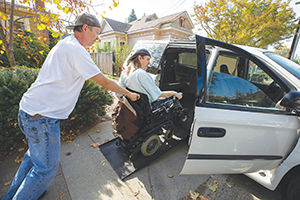
Dirk Collins, left, and his brother Darin evacuate their home in Healdsburg, Calif., Oct 26, ahead of strong winds that could heighten wildfire risks. The Sonoma County Sheriff's Office said it would be the biggest evacuation in the county in more than 25 years. Evacuations can be especially difficult for people with health conditions and disabilities.
John Burgess/The Press Democrat via AP
This way, if a real disaster occurs, chances are better that both hospital staff and community members will be prepared.
"This is important to us because these are our neighbors and friends," and they will fare better in an emergency if they and the hospital have practiced their response, Rowen said.
Rowen is among several emergency management experts from around the Catholic health ministry who told Catholic Health World that their facilities are going well beyond what regulators require them to do to prepare for disasters, in order to be ready to aid vulnerable people in their hospitals and in their communities. These experts said that people who are very young or elderly, disabled, chronically ill, homeless, mentally ill or non-English speaking are at heightened risk when disaster strikes. Advance preparations can reduce their vulnerability, they said.
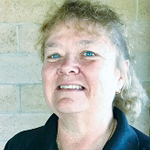
Rowen
In addition to Rowen, whose hospital is a member of CommonSpirit Health, Dr. Osbert Blow, president and chief medical officer of CHRISTUS Spohn Health System of Corpus Christi, Texas; Brian Boudreau, manager of safety and emergency preparedness, and Manuel Fernandez Villaderey, emergency management specialist, both of St. Peter's Health Partners of Albany, N.Y., in the Trinity Health system; and Kenneth Luke, disaster, base station, and infectious diseases coordinator for Dignity Health Mercy Medical Center of Redding, Calif., part of CommonSpirit, discussed emergency management response for special needs populations with Catholic Health World.

Blow
Groupthink
Blow said CHRISTUS has leaders who participate in a southeast Texas coalition called Coastal Bend Regional Advisory Council. It is made up of health care, emergency response and governmental bodies along the Texas coast that coordinate their disaster planning and response activities. A central focus is evacuating areas deemed at highest life safety risk in the projected path of a strong hurricane.
Blow, some CHRISTUS colleagues and others are on the Special Populations Committee of the coalition. It studies how vulnerable populations can be protected, and their current focus is on people who are homeless. Blow says the committee has set out plans for assisting homeless people in evacuating or finding safe shelter before a hurricane. The committee also has taken flu vaccinations out to homeless people and passed out water bottles during hot weather.
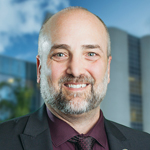
Luke
Rowen represents St. Elizabeth on a health care coalition focused on emergency preparedness for two Northern California counties. Its membership includes acute care facilities, long-term care facilities, outpatient clinics, dialysis facilities, public health agencies, local emergency management agencies, organizations for the disabled, schools, emergency medical services, tribal health care entities and "nearly anyone else that would deal with our residents in a medical or health role," Rowen said.
She and her emergency management colleagues at St. Elizabeth work with schools, first responders, and eldercare and disability groups. They aid those organizations in building and refining emergency plans and in assuring their plans are coordinated with others in the community.
Rowen said networking is a big part of her job. Community leaders who are responsible for disaster preparedness for their organizations "need to know us and trust us" so the hospital and those representatives will connect and share information in an emergency.
Rowen said St. Elizabeth disseminates information about personal and organizational disaster preparedness at community fairs, health and safety events and the Special Olympics. St. Elizabeth staff presents a human face for the hospital, so community members will have a positive impression of the hospital before they must trust it in an emergency.
Her department works with schools and disability groups to drill on emergency response, such as staging a decontamination demonstration with schoolkids. The department enlisted community organizations to recruit non-English speakers who tested the effectiveness of using pictorial aids to explain mass vaccination activities that may be needed in a disaster.
Caring for kids
Luke said Mercy Medical also prioritizes relationship-building with community members and organizations, to lay a foundation of trust before disaster strikes. "A hospital is one of the most critical pieces of a community's infrastructure, and when people don't know what to do, they will often go to a hospital," and that's why the connections are so important.
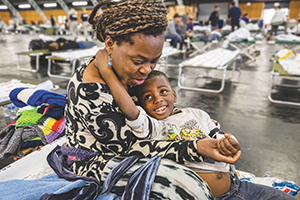
Bernadette Yabadi and her son Victor settle into a Red Cross shelter at the Sonoma County Fairgrounds in Santa Rosa, Calif., Oct. 27, after evacuating their home as a fire safety precaution. St. Joseph Health’s Sonoma County outreach staff provided basic primary care at some shelters during the emergency. John Burgess/The Press Democrat via AP
Mercy Medical has coordinated emergency preparedness training that specifically covers pediatric disaster response. Funded through the Department of Homeland Security and a branch of the Federal Emergency Management Agency, the course taught first responders, Mercy Medical staff and representatives from local organizations how to interact with distressed and overwhelmed children during or after a disaster. They also learned how to safely shelter children in a weather event and reunify children with loved ones if they've been separated during a crisis, and they learned procedures used in decontamination of children exposed to toxic chemicals.
Luke explained, "They are not just little adults, and their care should be totally different than adults' care."
Mental health corps
Boudreau and Fernandez Villaderey said St. Peter's in Albany has anticipated that distressed, vulnerable people will need extra comfort in a crisis, and so as part of their disaster preparation their department, the health system's Office of Safety and Emergency Preparedness, has facilitated training in Mental Health First Aid for 140-plus hospital colleagues.
In a mass casualty incident or disaster, these individuals can be dispatched quickly to provide mental health triage and referrals to mental health providers, as appropriate.
The four-hour training sessions cover how to speak to a traumatized person in a manner that calms rather than retraumatizes them. This includes how staff can tailor their communications with members of vulnerable groups including children, elders and people who are mentally ill.
Fernandez Villaderey said this training is for when "we're the very first touch" after a disaster. "We want to provide that friendly voice, we want to emphasize we'll help them. We want (vulnerable people) to feel comfortable and safe here."
The November-December issue of Health Progress includes a special section on disaster response and vulnerable populations.
Ministry staff help frail patients stay safe amid Northern California fires
Mobile teams tend to homebound, evacuees, homeless people
Wildfires and power outages that impacted millions of Californians in October and early November put the frail elderly and homebound in particular danger.
"Especially for people who are homebound, it is very scary to be in a bed that they know they can't get out of, and know there's a fire," said Sandy Jay, a family nurse practitioner and supervisor of the House Calls primary care program and mobile clinic for St. Joseph Health Sonoma County. "We are all nervous, but those people are really traumatized by something like this."
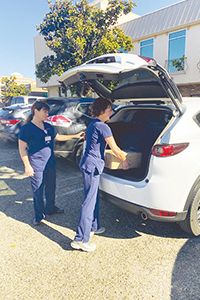
Registered nurses Laura Heronand, right, and Tracy Norman load medical supplies for delivery to home care patients impacted by a planned power shutoff in October intended to reduce wildfire risk. The nurses practice in Dignity Health's North State region, which includes the northernmost counties of California.
The outages and wildfires affected communities throughout California this month and last, and Catholic providers throughout the state assisted in the response. Catholic Health World spoke to ministry home health and community outreach teams aiding vulnerable community members in Northern California.
St. Joseph Health, which is part of Providence St. Joseph Health, and CommonSpirit Health's Dignity Health reported their respective home health staffs in areas threatened by fire or blackouts provided direct care, medication and guidance to ensure the well-being of vulnerable patients. Outreach teams from both systems also provided basic primary care to evacuees and homeless people in affected areas, administering steroids, inhalers and antibiotics to those experiencing respiratory issues from the heavy smoke.
Rolling power outages
Charlotte Haisch, Dignity Health North State director of home health and hospice, said her staff kept in regular contact with more than 150 home health patients in the northernmost counties of Siskiyou, Shasta and Tehama where homes were left without power when California's largest electric utility began a wave of blackouts beginning Oct. 9.
Kristin Duarte, Dignity Health North State's emergency services coordinator for home health and hospice, said special attention was paid to patients dependent on electric-powered medical devices such as oxygen concentrators or temperature-sensitive medications to ensure the patients would be able to implement individualized contingency plans for access to electricity and refrigeration.
Dignity Health's Mercy Medical Center Redding and St. Elizabeth Community Hospital in Red Bluff, as well as St. Joseph Health's St. Joseph Hospital assisted outpatients who came to their emergency rooms to get oxygen tanks or battery-powered essential medical devices, or to recharge medical equipment.
Fire threat
St. Joseph Health's House Calls primary care service for the homebound has about 100 clients in Sonoma County, many of them bedbound, said Jay. Some of its patients live alone. About 10 patients were under mandatory evacuation orders due to fire when Jay spoke to Catholic Health World on Oct. 30, and her team was tracking their whereabouts and well-being.
Jay said her six-person team had been in regular contact with all 100 or so patients throughout the disaster, tracking their location and status, ensuring they were evacuated to a safe location, and ensuring their essential medical equipment was functioning properly. She noted that in a power outage, people in electric hospital beds who must be repositioned on a schedule to prevent pressure sores, and those whose oxygen equipment requires electricity are particularly vulnerable.
She said her team had been making more than its usual number of in-person, at-home visits to check on clients experiencing heightened difficulty, and making pharmacy runs to deliver patients' prescription medications when usual pharmacy delivery services were interrupted.
What is needed in crises like wildfires and widespread power outages are staff "who are ready, willing and able to do what needs to be done at the moment," Jay said.
As part of his role, Dan Schurman oversees a St. Joseph Health's mobile clinic in Sonoma County. The clinic is staffed by two nurse practitioners and three medical assistants. It makes regularly scheduled visits to homeless shelters and other locations to reach people with little or no usual access to care. Schurman said that during the fires, the mobile unit also provided basic primary care at churches near evacuation centers.
When high winds made it too dangerous for the mobile clinic to be on the road, nurses and medical assistants grabbed their medical "go bags" — and traveled by car to care sites.
— JULIE MINDA
FEMA offers tips to help vulnerable people prepare for disaster
How well an older person, or a person with a disability, fares in a disaster can be greatly impacted by how effectively that individual or his or her caregivers have anticipated and planned for the catastrophe and its immediate aftermath.
At ready.gov, and on its app, the Federal Emergency Management Agency provides guides to help people and organizations plan for disasters and emergencies of all kinds including fires, floods and terrorist attacks. FEMA disaster preparation brochures are tailored to various populations and can be ordered in multiple languages.
There are checklists and other information that address the particular needs of older Americans, people with disabilities and families with young children.
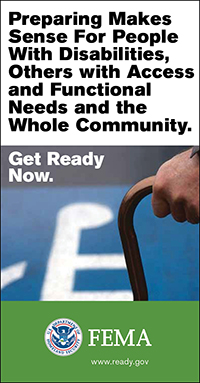
The Federal Emergency Management Agency provides brochures in several languages to help people plan to be self-sufficient in the days following a major disaster.
Linda Mastandrea directs FEMA's Office of Disability Integration and Coordination, which helps individuals, communities, organizations and emergency management agencies across the country to prepare for disaster. Mastandrea said FEMA's state and local counterparts are charged with educating people — including frail elderly and people with disabilities — about how they can best prepare to stay safe in an emergency and its aftermath.
Those local agencies also build linkages "when the sky is blue," with organizations that serve the vulnerable, to determine together how best to encourage clients in making disaster plans specific to their individual situation.
Ways to prepare
The agency encourages everyone to lay in basic emergency supplies to survive on their own for three days including water and food, flashlights, a battery-operated radio, extra batteries and other essentials.
The online checklists for people with disabilities recommends preparing two emergency supply kits — one for sheltering in place and a smaller kit to take along if it becomes necessary to leave the home — and the website offers detailed suggestions for the content of the kits.
FEMA advises that seniors and people with disabilities have on hand at least a week's supply of prescription medications and extra medical supplies. They should talk to their pharmacist or doctor about accessing care during a time of disruption, including by identifying backup service providers.
A patient who uses medical equipment that requires electricity will want to know what to do if the power goes out. FEMA recommends that an individual who relies on a motorized wheelchair have a lightweight portable wheelchair available for emergencies.
Advance preparation for individuals with a disability should include solidifying a plan with a personal support network of family and friends they can turn to in a disaster. One or more people in the network should be prepared and available to administer medicine and use lifesaving medical equipment in an emergency.
Seniors and individuals with disabilities should think in advance about how they'll make an informed decision to stay or go in an emergency, how they'll tend to the needs of pets and service animals and where they'll go if they must evacuate. Local emergency management agencies can provide help in this planning.
All people with serious illness or disabilities also should have ready to go information on their health history, copies of their prescriptions, the serial numbers of medical devices, contact information for medical providers and insurance cards.
— JULIE MINDA
'All-hazards' approach to disaster planning is the standard for health care organizations
Disaster response experts who spoke to Catholic Health World said that health care systems and facilities are required by regulators to take an "all-hazards" approach to disaster planning -- from fires, floods, tornados, hurricanes and other natural disasters to active shooters, terrorist attacks, chemical spills and other manmade calamities.
This planning work includes determining how every unit of the facilities will ready their staff, stock up on supplies, handle patient needs, work through the potential disasters, and interact with other hospital departments and with the community. Health systems and facilities refine these plans on an ongoing basis and drill on them regularly.
Organizations including the Centers for Medicare & Medicaid Services and the Joint Commission specify how health care facilities should undertake such planning and that they should coordinate with other key organizations including medical providers across the care continuum; city, county, state and federal agencies; schools; and frontline responders. Just this year alone, the Joint Commission added 23 standards pertaining to emergency preparedness for hospitals, home health care agencies, hospice, long-term care facilities and clinics, according to Kenneth Luke, disaster, base station, and infectious diseases coordinator for Dignity Health Mercy Medical Center of Redding, Calif.
— JULIE MINDA